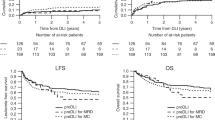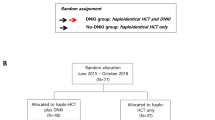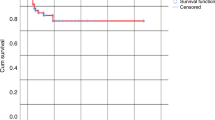Summary:
Donor lymphocyte infusions (DLI) are used to treat relapsed haematological diseases after allogeneic stem cell transplantation (SCT). We treated seven patients with DLI for indolent non-Hodgkin's lymphoma relapsed after SCT. In available blood and bone marrow samples, lymphoma cells were analysed by real-time quantitative polymerase chain reaction of t(14;18)-positive cells in follicular lymphoma, and by immunophenotyping in small lymphocytic lymphoma. Before DLI, three patients were treated with chemo- and/or radiotherapy, and one with rituximab. Evaluable responses to pre-DLI therapy were stable disease in one and partial remission (PR) in two patients. Six patients responded to DLI (complete remission (CR) in four and PR in two). After DLI, acute graft-versus-host disease (GVHD) occurred in 3/6 patients, classified as grade 2, whereas only limited chronic GVHD was seen (n=5). The four continuous CR are lasting for median 65+ (43–89) months. In the remaining patient, not responding to DLI, progressive disease was seen later on; chemotherapy followed by another DLI resulted in CR. In three cases, clinical responses to DLI could be substantiated by molecular or immunophenotypic analysis of lymphoma cells. We conclude that DLI is effective for treatment of indolent lymphoma relapsing after SCT.
This is a preview of subscription content, access via your institution
Access options
Subscribe to this journal
Receive 12 print issues and online access
$259.00 per year
only $21.58 per issue
Buy this article
- Purchase on Springer Link
- Instant access to full article PDF
Prices may be subject to local taxes which are calculated during checkout



Similar content being viewed by others
References
Verdonck LF, Dekker AW, Lokhorst HM et al. Allogeneic versus autologous bone marrow transplantation for refractory and recurrent low-grade non-Hodgkin's lymphoma. Blood 1997; 90: 4201–4205.
Van Besien K, Sobocinski KA, Rowlings PA et al. Allogeneic bone marrow transplantation for low grade lymphoma. Blood 1998; 92: 1832–1836.
Mandigers CMPW, Raemaekers JMM, Schattenberg AVMB et al. Allogeneic bone marrow transplantation with T-cell depleted marrow grafts for patients with poor-risk relapsed low-grade non-Hodgkin's lymphoma. Br J Haematol 1998; 100: 198–206.
Gribben JG, Neuberg D, Barber M et al. Detection of residual lymphoma cells by polymerase chain reaction in peripheral blood is significantly less predictive for relapse than detection in bone marrow. Blood 1994; 83: 3800–3807.
Bierman PJ, Vose JM, Anderson JR et al. High-dose therapy with autologous hematopoietic rescue for follicular low-grade non-Hodgkin's lymphoma. J Clin Oncol 1997; 15: 445–450.
Jones RJ, Ambinder RF, Piantadosi S, Santos GW . Evidence of a graft-versus-lymphoma effect associated with allogeneic bone marrow transplantation. Blood 1991; 77: 649–653.
Van Besien KW, De Lima M, Giralt SA et al. Management of lymphoma recurrence after allogeneic transplantation: the relevance of graft-versus-lymphoma effect. Bone Marrow Transplant 1997; 19: 977–982.
Bär BMAM, Schattenberg A, Mensink EJBM et al. Donor leukocyte infusions for chronic myeloid leukemia relapsed after allogeneic bone marrow transplantation. J Clin Oncol 1993; 11: 513–519.
Kolb HJ, Schattenberg A, Goldman JM et al. for the European Group for Blood and Marrow Transplantation Working Party Chronic Leukemia. Graft-versus-leukemia effect of donor lymphocyte transfusions in marrow grafted patients. Blood 1995; 86: 2041–2050.
Collins RH, Shpilberg O, Drobyski WR et al. Donor leukocyte infusions in 140 patients with relapsed malignancy after allogeneic bone marrow transplantation. J Clin Oncol 1997; 15: 433–444.
Verdonck LF, Lokhorst HM, Dekker AW et al. Graft-versus-myeloma effect in two cases. Lancet 1996; 347: 800–801.
Lokhorst HM, Schattenberg A, Cornelissen JJ et al. Donor leukocyte infusions are effective in relapsed multiple myeloma after allogeneic bone marrow transplantation. Blood 1997; 90: 4206–4211.
Khouri IF, Keating M, Korbling M et al. Transplant-lite: induction of graft-versus-malignancy using fludarabine-based nonablative chemotherapy and allogeneic blood progenitor-cell transplantation as treatment for lymphoid malignancies. J Clin Oncol 1998; 16: 2817–2824.
Hunault-Berger M, Ifrah N, Solal-Celigny P . Intensive therapies in follicular non-Hodgkin's lymphomas. Blood 2002; 100: 1141–1152.
Branson K, Chopra R, Kottaridis PD et al. Role of nonmyeloablative allogeneic stem-cell transplantation after failure of autologous transplantation in patients with lymphoproliferative malignancies. J Clin Oncol 2002; 20: 4022–4031.
Mandigers CMPW, Meijerink JPP, Raemaekers JMM et al. Graft-versus-lymphoma effect of donor leucocyte infusion shown by real-time quantitative PCR analysis of t(14;18). Lancet 1998; 352: 1522–1523.
De Witte T, Hoogenhout J, de Pauw B et al. Depletion of donor lymphocytes by counterflow centrifugation successfully prevents acute graft-versus-host disease in matched allogeneic marrow transplantation. Blood 1986; 67: 1302–1308.
Verdonck LF, de Gast GC, van Heugten HG et al. A fixed low number of T cells in HLA-identical allogeneic bone marrow transplantation. Blood 1990; 75: 776–780.
Glucksberg H, Storb R, Fefer A et al. Clinical manifestations of graft-versus-host disease in human recipients of marrow from HLA-matched sibling donors. Transplantation 1974; 18: 295–304.
Shulman HM, Sullivan KM, Weiden PL et al. Chronic graft-versus-host syndrome in man; a long-term clinicopathologic study of 20 Seattle patients. Am J Med 1980; 69: 204–217.
Meijerink J, Mandigers C, Van de Locht L et al. A novel method to compensate for different amplification efficiencies between patient DNA samples in quantitative real-time PCR. J Mol Diagn (Part B of Am J Pathol) 2001; 3: 55–61.
Mandigers CMPW, Meijerink JPP, Mensink EJBM et al. Lack of correlation between numbers of circulating t(14;18) positive cells and response to first-line treatment in follicular lymphoma. Blood 2001; 98: 940–944.
Acknowledgements
We kindly thank Evelyn Tönnissen (Central Hematology Laboratory, University Medical Center Nijmegen, The Netherlands) for technical assistance.
Author information
Authors and Affiliations
Corresponding author
Rights and permissions
About this article
Cite this article
Mandigers, C., Verdonck, L., Meijerink, J. et al. Graft-versus-lymphoma effect of donor lymphocyte infusion in indolent lymphomas relapsed after allogeneic stem cell transplantation. Bone Marrow Transplant 32, 1159–1163 (2003). https://doi.org/10.1038/sj.bmt.1704290
Received:
Accepted:
Published:
Issue Date:
DOI: https://doi.org/10.1038/sj.bmt.1704290
Keywords
This article is cited by
-
Cellular Immunotherapy in Lymphoma: Beyond CART Cells
Current Treatment Options in Oncology (2020)
-
Long-term survival outcomes of reduced-intensity allogeneic or autologous transplantation in relapsed grade 3 follicular lymphoma
Bone Marrow Transplantation (2016)
-
Allogeneic stem cell transplantation in patients with de novo diffuse large B-cell lymphoma who experienced relapse or progression after autologous stem cell transplantation: a Korea–Japan collaborative study
Annals of Hematology (2014)
-
The outcome of reduced intensity allogeneic stem cell transplantation and autologous stem cell transplantation when performed as a first transplant strategy in relapsed follicular lymphoma: an analysis from the Lymphoma Working Party of the EBMT
Bone Marrow Transplantation (2013)
-
Clinical outcomes of allogeneic stem cell transplantation for relapsed or refractory follicular lymphoma: a retrospective analysis by the Fukuoka Blood and Marrow Transplantation Group
International Journal of Hematology (2013)



